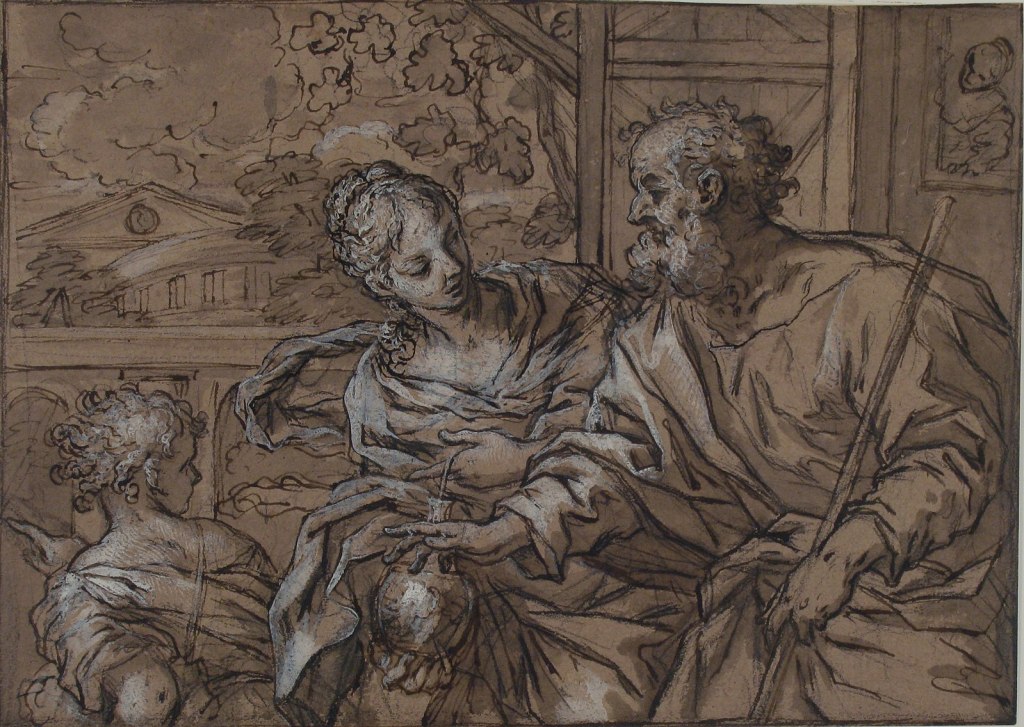
Like many of the women of the Bible we don’t know the name of our next woman, only that she was Lot’s Wife (although in some Jewish traditions she’s named Ado or Edith). We know very little about her other than she had two daughters and that she lived in Sodom, a town with a long-lasting reputation for being rather seedy. Although we know very little about her life she’s mainly remembered for the manner of her death: being turned into a pillar of salt as punishment for turning around to look back at her burning home.
It’s a curious story.
Lot was Abraham’s nephew and he settled the land called the Plain of Jordan (better known as Sodom), whilst Abraham settled in Caanan.
The enigmatic angelic visitors who had visited Abraham and Sarah then headed towards the city of Sodom. Lot, who was sitting at the City gate, greeted them and invited them to his home and his wife provided a feast for them. However, before they’d finished eating the ‘men of the city’ surrounded the house demanding the visitors be given over to them ‘so that we may know them’ (Genesis 19.5). Lot refused to allow the men into his home and instead offered them his own virgin daughters.
Much has been written of these passages in relation to sexuality, and they have been used as justification of God’s displeasure at same-sex relationships. This is simply wrong. This is not a passage about relationships, same-sex or otherwise: it is about violence. The men of Sodom want to rape Lot’s visitors, and so he protects them by offering his own daughters instead.
The angelic visitors strike the rampaging Sodomites with blindness so they can’t find the door and then they urge the family to flee before the city is destroyed. They were told:
Flee for your life; do not look back or stop anywhere in the Plain; flee to the hills, or else you will be consumed.
Genesis 19.17
As the family flee, the cities of Sodom and neighbouring Gomorrah are both destroyed in a shower of ‘sulphur and fire from the Lord out of heaven’.
But Lot’s wife, behind him, looked back, and she became a pillar of salt
Genesis 19:26
Why did she look back? And why salt? It’s all very strange.
I’ve often heard it said the reason she looked back was that she she lacked faith, but this seems overly harsh. Perhaps she was grieving a place which held all her childhood memories; or maybe she felt closer to the people in Sodom than to her husband, a man who would offer up his own daughters to be raped in order to protect some visitors; or perhaps she was simply terrified and frozen to the spot by the horror she was seeing.

It is interesting to note that the ‘Pillar of Salt’ is also an ancient legend told to explain some curious salt rock formations in this region.
Also, being turned into a pillar of salt is an idiom in Eastern tradition for dying of fright.
Whatever happened to Lot’s wife, she reminds us of thousands of women forced to flee their homes each day due to violence, war and natural disaster. She reminds us of all those who look back and remember all those they’ve left behind.
But perhaps she also reminds us that in this time of Lent we are also invited to turn – to turn towards God, who receives us with open arms of love.
Prayer
The UN Refugee Agency estimates that there are 70.8 million forcibly displaced people in the world today and 37,000 people each day flee their homes due to conflict or persecution. (see here for figures at a glance: https://www.unhcr.org/ph/figures-at-a-glance)
Answer me, O Lord, for your steadfast love is good; according to your abundant mercy, turn to me. Psalm 69.16
God of love, as we remember Lot’s wife who had to turn away from her home in fear, we remember all those today who are forced to leave their homes and face an uncertain future. Give them your strength and show them your love. We pray also that, in this time of lent, we might turn towards your love and know your peace in our lives. Amen





